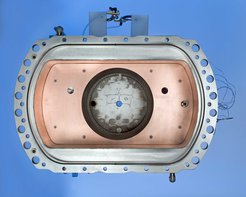IPP technology chosen for ITER
New type of heating for the ITER fusion test reactor / ten times as hot as the sun

This was now decided, after a unanimous recommendation was made by the international body of experts responsible for changes of plan. “For IPP this is a great success crowning many years of development work”, as division head Dr. Eckehart Speth was happy to announce (see IPP press release 13/05 "Eine Heizung für den Fusionstestreaktor ITER" (in German language)).
The ITER (Latin for “the way”) test device is the next major step in international fusion research. Construction of the device is to commence at Cadarache, France, in the coming year in a cooperation comprising seven partners – Europe, Japan, USA, Russia, China, India and South Korea. With a generated fusion power of 500 megawatts – ten times as much as will be needed to heat the plasma beforehand – ITER is to demonstrate that an energy-yielding fusion fire is possible.
Like the sun, a fusion power plant is to derive energy from fusion of atomic nuclei. For this purpose the fuel – an ionised low-density gas, a “plasma” – has to be successfully confined in a magnetic field cage without touching the vessel wall and heated to temperatures of over 100 million degrees. In ITER about half of this is to be accomplished with “neutral particle heating”: Fast hydrogen atoms injected into the plasma transfer their energy to the plasma particles on colliding with them. Today’s devices can thus attain many times the sun’s temperature at the press of a button. The ITER large-scale device, however, imposes new requirements on the established procedure: For example, the particles have to be three to four times faster than hitherto so that they can penetrate deep enough into the voluminous plasma.
In view of these increased requirements the heating method developed at IPP affords appreciable advantages over the solutions available to date. The new source – an achievement for which the team around Dr. Speth was awarded the Erwin Schrödinger Prize of the Helmholtz Association in 2006 – is, for example, particularly robust and needs little maintenance. Since 2002 IPP has been further developing the original version of the source, successfully operated in IPP’s ASDEX Upgrade experiment since 1995, to make it satisfy ITER’s requirements. The results achieved on three test rigs at IPP have now convinced the ITER team: “New technique takes time to assert itself”, as Dr. Speth puts it. But the development work has not come to an end with the decision now taken. A further test rig for a source half the size of that for ITER is to be built shortly at IPP. This is to check whether the particle beam can meet the requirements for ITER. The system in the original size is then to be investigated by Italy’s ENEA fusion institute at Padua.
Isabella Milch
